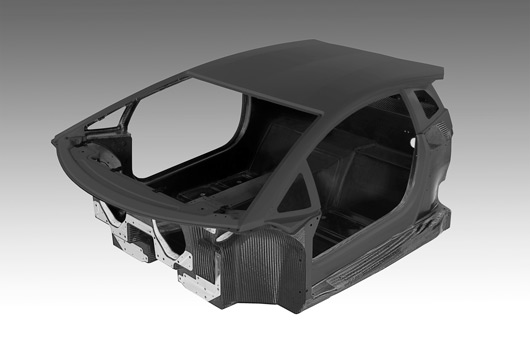
Overnight Lamborghini released a further image of the carbon fibre chassis from its new V12-powered Murcielago replacement. However, the image creating all the waves is this leaked pic of the new LP 700-4, aka Aventador, which was published by Evo Magazine Croatia and sent in to WorldCarFans.
We’ll get a full, and official, look at the Aventador in a week or so at the Geneva Motor Show. After the break you can see the pics Lamborghini actually want you to see.
Lamborghini unveils V12 rolling chassis in advance of car’s Geneva launch
22/02/2011 – At a TechDay event, Automobili Lamborghini unveils the rolling chassis of its new V12 to be launched at Geneva motor show on 1st March.
Geneva 2011 – Lamborghini makes no compromises in the engineering and construction of its new flagship’s all-carbon fiber monocoque
- Monocoque forms a single shell in carbon fiber
- Built entirely in-house by Lamborghini with patented process
11/02/2011 – Lamborghini’s Geneva motor show launch of its Murciélago replacement promises an extraordinary new technology-driven super sports car. One significant feature will be the extensive use of carbon fiber-reinforced polymer (CFRP) technology throughout the car, and in particular, in the entirely carbon fiber composite monocoque.
The cell of the future Lamborghini flagship super sports car is made entirely from carbon fiber and has been designed as a monocoque structure. The load-bearing structure of the vehicle is engineered as a “single shell†that functions physically as one component, thus taking full advantage of the extreme rigidity of CFRP. Formula 1 race cars have been built using CFRP monocoques for many years – and have proven their crash worthiness time and again. The same applies to road-going sports cars featuring monocoque technology – the carbon fiber occupant cell functions like an extremely safe roll cage.
Construction offer many advantages
Of course, the term “single shell†applies only in the descriptive sense – the new Lamborghini monocoque is made from a series of individual parts with specific functions, such as stiffening elements made from Braiding technology, that is one of the best technology to manage energy adsorption in case of crash. After the curing process, however, this structure functions as a single component – including the base section known as the tub and the complete roof.
The full monocoque solution offers advantages which other processes, like a tub where a metal roof structure is attached in a conventional manner, cannot realize. That’s why Lamborghini made the no compromise choice of the full monocoque, which weighs only 147.5 kilograms (324.5 lbs).
Extremely rigid construction
Superior passive safety is only one benefit of the extreme rigidity of a full carbon fiber monocoque – very high torsional rigidity is another. The monocoque is connected at the front and rear with equally rigid aluminum sub-frames, on which the suspension, engine and transmission are mounted.
The entire body-in-white of the future V12 model weighs only 229.5 kilograms (505 lbs) and boasts phenomenal torsional rigidity of 35,000 Newton meters per degree of twist. This guarantees a superb feeling of solidity, but, more importantly, extremely exact wheel control with excellent steering precision and sensitive feedback. For the dedicated driver, both are essential for truly enticing driving pleasure. The new Lamborghini flagship responds to the most minute steering input with the stunning precision of a perfectly balanced race car.
Depending on the form, function and requirements of the individual elements, the Lamborghini development team selected from three main CFRP manufacturing methods within its technology tool kit. They differ not only in their production processes, but also in the type of carbon fiber and its weave and, most importantly, in the chemical composition of the synthetic resin used.
Resin Transfer Moulding (RTM): In this process the carbon fiber mats are preformed and impregnated with an exact amount of resin. Afterwards, they are cured under heat while the part is in the mold. Lamborghini has achieved a major breakthrough by further developmening this method. Using the patented “RTM-Lambo†process, the final mold is no longer a heavy, complex metal piece, but is made instead from lightweight carbon-fiber parts, thus making the manufacturing process faster, more flexible and more efficient.
An additional benefit of the RTM-Lambo process is the low injection pressure that doesn’t require expensive equipment.
Prepreg – The carbon fiber mats used in this method, commonly known as prepreg, are pre-injected by the supplier with a thermosetting liquid resin and must be stored at a low temperature. The mats are then laminated in molds and cured under heat and pressure in an autoclave. Prepreg components are complex to make, but have an extremely high-quality surface finish (Class-A surface quality) and are therefore the preferred option for use in visible locations.
Braiding – These components are manufactured by using RTM technology. This carbon fiber weave technology is derived from the textile industry and used to make tubular components for special applications such as structural roof pillars and rocker panels. The woven components are made by diagonally interweaving the fiber in several layers.
The monocoque of the new V12 super sports car is constructed using these technologies applied in a series of special processes. One significant advancement Lamborghini realized is the ability to use already-assembled monocoque elements as the mold for the next step in the process. This makes for a considerable simplification of the manufacturing process compared with conventional methods.
Epoxy foam components are also used within the monocoque. They are placed in strategic points to increase the stiffness of the monocoque by working as spacers between the composite layers while also dampening noise and vibration. In addition, aluminum inserts are laminated into the front and rear surfaces to facilitate connection with the aluminum front and rear sub-frame elements.
Because of the complexity of the materials and process outlined above, Lamborghini decided to produce its new monocoque completely in-house, managing one strategic step in the production process.
Quality control is an absolutely crucial factor – every single monocoque is measured to exacting tolerances of only 0.1 millimeters, facilitating the extreme precision of the overall vehicle. Quality control starts with the purchase of the carbon fiber parts. Every delivery of carbon fiber is certified and the material is checked regularly for compliance with quality standards. Lamborghini worked together with its suppliers to develop a world-exclusive fiber and resin system for its RTM technology. Ultimately, these materials and processes constitute an important part of Lamborghini’s worldwide leading expertise in the field.
Carbon composite materials – A key technology for tomorrow’s high-performance automotive engineering
These materials made from CFRP combine the lowest possible weight with excellent material characteristics – they are very light, extremely rigid and exceptionally precise.
Furthermore, CFRP materials can also be formed into highly complex components with integrated functions. This reduces the number of individual parts when compared to traditional metal construction – thus enabling further weight reduction. Lighter cars have lower fuel consumption and fewer CO2 emissions. Most significantly, however, it improves the power-to-weight ratio – the deciding factor in the overall feel and performance of a sports car. A super sports car built using CFRP accelerates faster, has superior handling and better braking.


2 replies on “Hey look, it’s the Lamborghini Aventador!”
[…] this week’s earlier leak these new images have raised the bar and, really, we only need to see what the inside looks like to […]
Lamborghini Aventador is one of the best supercar. Especially with the new machine, it will add to malignancy performance of the car .. .
thanks the information, good post. .